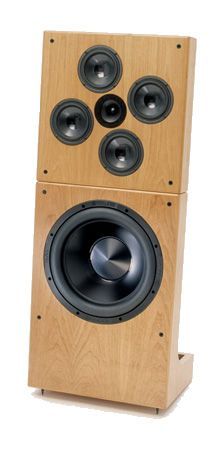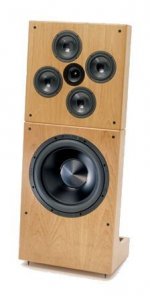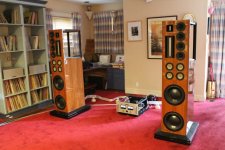Hi all, I'm going to use 4 midranges with 1 AMT tweeter per side in my new build. All this as a "line array" on top of eachother and the whole section of course on top of the 1x 18" (maybe 21") woofer.
But I think I might ask you what you think about the arrangement of all these.
Considerations:
- Knowing the directional pattern of AMTs (narrow vertically), keeping tweeter at/around head height is crucial. I'll be sitting on the sofa most of the listening time. I try to imagine woofer height + box wall thicknesses + 4x 6" midranges on top of eachother as close as possible + tweeter. Tweeter might be a bit high, especially when the whole midrange section is on top of a 21" woofer (bigger diameter obviously than a 18" woofer).
- in this setup, the tweeter's VC plane will be shifted a bit to the back to be time-aligned with midrange voice coils to maintain a straight forward pointing lobe (active setup, 3-way 4th order LR).
- What do you think of going MTM with a flat front plate ? M-M-T-M-M ? Inspired by Status Acoustic's Titus 8T. I know MTMs have a straight forward pointing lobe as well, but more narrow vertically than a single M-T setup (or M-M-T).
- What do you think about doubling the tweeters ? (No sensitivity and impedance issues in an active setup). Like M-T-M-M-T-M. 2 lobes on top of eachother or do we have some nice advantages here ?
- 4 tweeters ? (Although cost is insane then). M-T-M-T-M-T-M-T. It might behave like a line array, a vertical cylindrical lobe. Inspired by PS Audio's Infinity IRS V (in a smaller form factor).
- Or nothing to do at all, staying with M-M-M-M-T as originally intended ? I won't sit very close to the speakers so despite tweeter being a very little bit above head position it still might be a good setup.
Any opinions are welcome.
But I think I might ask you what you think about the arrangement of all these.
Considerations:
- Knowing the directional pattern of AMTs (narrow vertically), keeping tweeter at/around head height is crucial. I'll be sitting on the sofa most of the listening time. I try to imagine woofer height + box wall thicknesses + 4x 6" midranges on top of eachother as close as possible + tweeter. Tweeter might be a bit high, especially when the whole midrange section is on top of a 21" woofer (bigger diameter obviously than a 18" woofer).
- in this setup, the tweeter's VC plane will be shifted a bit to the back to be time-aligned with midrange voice coils to maintain a straight forward pointing lobe (active setup, 3-way 4th order LR).
- What do you think of going MTM with a flat front plate ? M-M-T-M-M ? Inspired by Status Acoustic's Titus 8T. I know MTMs have a straight forward pointing lobe as well, but more narrow vertically than a single M-T setup (or M-M-T).
- What do you think about doubling the tweeters ? (No sensitivity and impedance issues in an active setup). Like M-T-M-M-T-M. 2 lobes on top of eachother or do we have some nice advantages here ?
- 4 tweeters ? (Although cost is insane then). M-T-M-T-M-T-M-T. It might behave like a line array, a vertical cylindrical lobe. Inspired by PS Audio's Infinity IRS V (in a smaller form factor).
- Or nothing to do at all, staying with M-M-M-M-T as originally intended ? I won't sit very close to the speakers so despite tweeter being a very little bit above head position it still might be a good setup.
Any opinions are welcome.
Last edited:
I'm not a line array expert by any means, but I would put the tweeter next to the line of midranges at ear height.
Keeping the midranges in a line may have advantages in vertical dispersion to better match the tweeter.
I don't think that the crossover will be significantly harder side by side vs. the mmTmm, etc.
If you are doing a passive crossover, I would add enough tweeters to roughly match sensitivity. For active, not so much.
I would also look at a Chaucer Elliptical crossover. I understand you get less phase shift for the same target slope than the comparable Butterworth or Linkwitz Riley topologies. YMMV, LOL.
HTH
Keeping the midranges in a line may have advantages in vertical dispersion to better match the tweeter.
I don't think that the crossover will be significantly harder side by side vs. the mmTmm, etc.
If you are doing a passive crossover, I would add enough tweeters to roughly match sensitivity. For active, not so much.
I would also look at a Chaucer Elliptical crossover. I understand you get less phase shift for the same target slope than the comparable Butterworth or Linkwitz Riley topologies. YMMV, LOL.
HTH
Hmm now you all made me think ..thanks for the suggestions.
I know the most ideal source of sound is point-like and I'd like to be close to this at least on one plane: horizontally. Thats's why I wouldn't try to put tweeter next to the midranges but rather do MMTMM or MMMMT. However I haven't heard of any midranges put next to eachother this way (e.g. 4 midranges in a 2x2 setup) .. until (and below) a certain frequency and center to center distance they might behave as 1 midrange unit together.. hmm this is a white spot on my map, I'm a little bit afraid of it. But I might try this in 2x2 with the tweeter next to them, the M-T box is a separate one and I can have both versions made and listen to them for a while before painting.
But I might try this in 2x2 with the tweeter next to them, the M-T box is a separate one and I can have both versions made and listen to them for a while before painting.
I know the most ideal source of sound is point-like and I'd like to be close to this at least on one plane: horizontally. Thats's why I wouldn't try to put tweeter next to the midranges but rather do MMTMM or MMMMT. However I haven't heard of any midranges put next to eachother this way (e.g. 4 midranges in a 2x2 setup) .. until (and below) a certain frequency and center to center distance they might behave as 1 midrange unit together.. hmm this is a white spot on my map, I'm a little bit afraid of it.
Depends where you intend to cross, but MMMMT might alleviate some floor bounce effects compared to MMTMM, and the cabinet is shorter too.
 Good argument, thanks.
Good argument, thanks. Planned crossover points are 125 Hz and 2 kHz.
The tweeter's factory recommendation is 1000 Hz with 12dB/octave 2nd order so I might go a bit lower than 2k but for safety reasons and power handling I chose 2k (and the filter is 24dB/oct 4th order).
Adason is right, this is how you do it:

You can find the patent online. The speaker was designed by the same dude who has the patent on the Aurasound Whisper.
A couple of forum members have published similar designs:
@melo theory : The Portal....a controlled dispersion tripole
@follgott : Pseudo-coaxial with narrow directivity (and Horbach-Keele filters)
If you build one, be careful with the spacing. If it becomes too large, you'll reach a point where you'll get a dip in the midrange that's impossible to fix. You want to keep that spacing tight.
You can find the patent online. The speaker was designed by the same dude who has the patent on the Aurasound Whisper.
A couple of forum members have published similar designs:
@melo theory : The Portal....a controlled dispersion tripole
@follgott : Pseudo-coaxial with narrow directivity (and Horbach-Keele filters)
If you build one, be careful with the spacing. If it becomes too large, you'll reach a point where you'll get a dip in the midrange that's impossible to fix. You want to keep that spacing tight.
Great, re-considering. I'll try both versions with 2 raw mdf boxes.. this one on the pic and the MMMMT original one. Then the measurement mic will tell the rest.
Do you know a maximum center-to-center distance for a certain frequency where above that freq. they don't behave as one ? Something with 1/2 wavelength or so ? Dunno anymore.. :/
Do you know a maximum center-to-center distance for a certain frequency where above that freq. they don't behave as one ? Something with 1/2 wavelength or so ? Dunno anymore.. :/
The tweeter's factory recommendation is 1000 Hz with 12dB/octave 2nd order so I might go a bit lower than 2k but for safety reasons and power handling I chose 2k (and the filter is 24dB/oct 4th order).
What AMT is that? I'm also toying with MTMs in various configurations with an AMT: Beyma TPL-150H, also recommended to 1kHz by Beyma. Also looking to xo at 2kHz. The TPL is large for xo at 2kHz making c-to-c a challenge.
I also considered using 2x3" or 2x4" side-by-side above the AMT and 2x4" below. Even a 2x2 or 3" above and and 2x2 3" below. Reduces the c-t-c between mids vertically, but was steered away from the notion because I was told the side by side midranges would create a blurred image...I guess I should try it out.
Hi, it's an Aurum Cantus AST25120. I'm also afraid of side-by-side midranges, at least now.
Last edited:
Do you know a maximum center-to-center distance for a certain frequency where above that freq. they don't behave as one ? Something with 1/2 wavelength or so ? Dunno anymore.. :/
Basically there are two different ways to space an MTM, IMHO:

1) Back in the 90s, there were a lot of speakers that used "one wavelength spacing." For instance, this Zalytron Aria 5 had a spacing of around 7" and a crossover of around 2khz

In 2018, there are a lot of good small midranges available. This allows for spacing of about 33%-40% of a wavelength.
Both options work. The first option is going to have a narrow beamwidth, because the spacing is so large. The second option will have a wide beamwidth, because the spacing is so tight.
Arguably the worst option is to use 1/2 wavelength spacing. Because that will create a null. (Because the drivers are out-of-phase at the xover point, due to them being 180 degrees out-of-phase.)
But this is an insanely complex topic, particularly because I didn't even touch on the fact that the crossover filters introduce a delay which will change the phase relationship.
My favorite paper on all of that is this:
http://www.linkwitzlab.com/Horbach-Keele Presentation Part 2 V4.pdf
Thanks for these examples. Wow.
My crossover will be this simple one here (re-calculated of course to my frequencies) and it doesn't seem to have any issues with phase. Or I miss something.
My crossover will be this simple one here (re-calculated of course to my frequencies) and it doesn't seem to have any issues with phase. Or I miss something.
This radial layout is great for a symmetrical hemispherical radiation pattern, but the AMT has a wide horizontal and narrow vertical pattern. My belief is a short shaded vertical array, either MMTMM or TMMM would match the AMT better.
Most probably I'll do it this way

One of my friends tried a little simulation in a small-average living room, showing the dispersion pattern of the 4 midranges. The simulation is far from perfect but still more than nothing .. interesting at least..
Side view
@1 kHz:

@ 2.4 kHz:

This might help to imagine the AMT stepping in at 2kHz on top of them with the same SPL with a vertical narrowly opening lobe.
Side view
@1 kHz:

@ 2.4 kHz:

This might help to imagine the AMT stepping in at 2kHz on top of them with the same SPL with a vertical narrowly opening lobe.
Last edited:
Szilard,
Do you have a topic in one of the Hungarian forums?
I cannot find the type of the mids, what are they?
I like MMTMM, highs in front of your ears. I think we are in the same city, if your project is in the phase when it can be lisened to, I would be happy to do it
Sandor
Do you have a topic in one of the Hungarian forums?
I cannot find the type of the mids, what are they?
I like MMTMM, highs in front of your ears. I think we are in the same city, if your project is in the phase when it can be lisened to, I would be happy to do it
Sandor
Hi Sandor, no, I don't, I'm registered on prohardver but I left the speaker DIY topic.
Projected outcome is around end of 2018 at least without paintwork on the mdf so if you wanna listen, don't expect a beauty. Or come in may 2019 for my birthday and you can see the whole setup in white piano finish.
Or come in may 2019 for my birthday and you can see the whole setup in white piano finish.  Your choice and you're welcome anytime.
Your choice and you're welcome anytime.
The mids will be 4x Faital 6FE100 drivers per side.
Projected outcome is around end of 2018 at least without paintwork on the mdf so if you wanna listen, don't expect a beauty.
 Your choice and you're welcome anytime.
Your choice and you're welcome anytime. The mids will be 4x Faital 6FE100 drivers per side.
Do you mean to say that 1 WL spacing is better than 1/2 WL?Arguably the worst option is to use 1/2 wavelength spacing. Because that will create a null. (Because the drivers are out-of-phase at the xover point, due to them being 180 degrees out-of-phase.)
At 1 WL spacing, a null occurs at 45deg off axis. I.e. the main lobe is 90deg wide.
At 1/2 WL spacing the null occurs at 90deg off axis, so the main lobe is 180deg wide
At 1/4 WL there are no deep nulls. 90deg off axis the response is only -3dB so it's close to omnidirectional radiation.
2 WL would give nulls at 22.5, 45 and 67.5 deg off axis.
If the aim is to avoid nulls, closer spacing is always better and further spacing is always worse. There are no magic numbers, so spacing as close as physically possible, even if some arbitrary fraction of a WL, is best.
- Status
- This old topic is closed. If you want to reopen this topic, contact a moderator using the "Report Post" button.
- Home
- Loudspeakers
- Multi-Way
- 4 midranges + 1 tweeter: do MTM or don't ?

